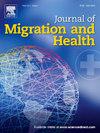孟加拉国考克斯巴扎尔被迫流离失所的缅甸国民/罗兴亚难民COVID-19保护行为的障碍和驱动因素:范围审查
IF 2.9
Q1 PUBLIC, ENVIRONMENTAL & OCCUPATIONAL HEALTH
引用次数: 0
摘要
大约90万被迫流离失所的缅甸国民(FDMN)/罗兴亚难民生活在孟加拉国考克斯巴扎尔的临时营地。在2019冠状病毒病大流行期间,在以往严重传染病暴发的背景下,保护行为尤为重要。为了确定这些行为的障碍、驱动因素和干预措施,我们于2021年10月对MEDLINE、Embase、Web of Science、Global Health和灰色文献进行了范围审查,并于2024年6月进行了更新。采用改进的能力-机会-动机-行为(COM-B)框架和行为改变轮对现有证据进行组织。共审查了4014份(2021年3654份、2024年360份)记录和51份(2021年38份、2024年13份)文章。文章报道了保护行为(一般概念)、洗手、保持社交距离、隔离/检疫、佩戴口罩、检测、治疗和疫苗接种。这些行为的障碍和驱动因素跨越了所有四个COM因素,反映了个人和环境的影响。最常被提及的障碍和驱动因素是动机(如信念、恐惧、信任)和物理机会(如信息、物理营地环境)因素。证据的差距在于保健服务提供者的看法,以及难民营和人口群体之间的差异。大多数干预措施侧重于信息、教育或培训(如运动、社区参与)和环境重组(如增加提供讲卫生设施、COVID-19隔离和治疗中心)。大多数文章报道了干预措施的建议。有一些执行的证据,但几乎没有评价。本综述确定了科克斯巴扎尔地区COVID-19防护行为的复杂且相互关联的障碍和驱动因素,以及解决这些问题的许多干预措施。解决上述证据差距将有助于今后制定针对特定人口群体需要的有效目标干预措施。本文章由计算机程序翻译,如有差异,请以英文原文为准。
Barriers and drivers to COVID-19 protective behaviours of forcibly displaced myanmar nationals (FDMN)/ rohingya refugees in Cox's bazar, Bangladesh: A scoping review
About 900.000 Forcibly Displaced Myanmar Nationals (FDMN)/ Rohingya refugees live in makeshift camps in Cox's Bazar, Bangladesh. During the COVID-19 pandemic, protective behaviors were particularly important in this setting of previous severe infectious disease outbreaks. To identify barriers, drivers and interventions for those behaviors, a scoping review of MEDLINE, Embase, Web of Science, Global Health and grey literature was conducted in October 2021 and updated in June 2024. The modified Capability-Opportunity-Motivation-Behavior (COM-B) framework and Behavior Change Wheel were used to organize available evidence. A total of 4014 (3654 in 2021, 360 in 2024) records were reviewed and 51 (38 in 2021, 13 in 2024) articles included. Articles reported on protective behaviors (as a general concept), handwashing, social distancing, isolation/quarantine, mask wearing, testing, treatment and vaccination. Barriers and drivers to these behaviors spanned all four COM factors reflecting both individual and environmental influences. Most frequently cited barriers and drivers were found in the motivation (e.g. belief, fear, trust) and physical opportunity (e.g. information, the physical camp environment) factors. Gaps in the evidence were views of health service providers, and differences between camps and population groups. Most interventions focused on information, education or training (e.g. campaigns, community engagement) and environmental restructuring (e.g. increased provision of WASH facilities, COVID-19 isolation and treatment centres). Most articles reported recommendations for interventions. There was some evidence of implementation but little evaluation. This review identified complex and inter-related barriers and drivers to COVID-19 protective behaviors in Cox's Bazar, and many interventions to address these. Addressing the above-mentioned evidence gaps would assist future development of effective targeted interventions, tailored to the needs of specific population groups.
求助全文
通过发布文献求助,成功后即可免费获取论文全文。
去求助
来源期刊

Journal of Migration and Health
Social Sciences-Sociology and Political Science
CiteScore
5.70
自引率
8.70%
发文量
65
审稿时长
153 days
 求助内容:
求助内容: 应助结果提醒方式:
应助结果提醒方式:


